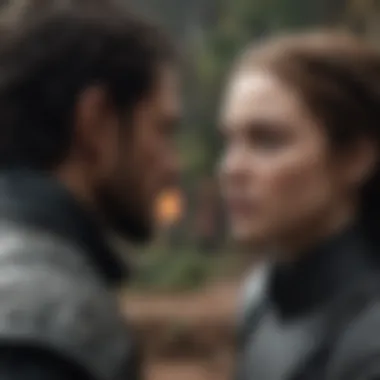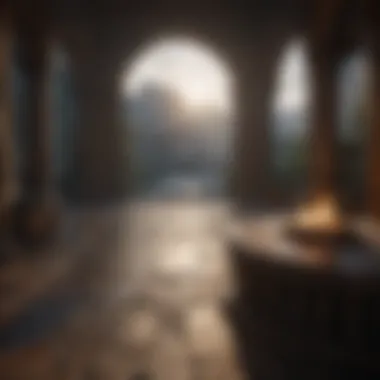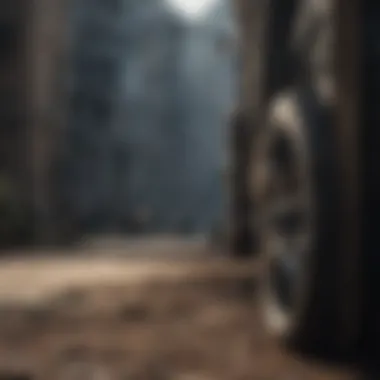Exploring the Depths of Game of Thrones Season 8, Episode 2


Intro
As we delve into the heart of Game of Thrones Season Eight, Episode Two, it becomes clear that this installment is not merely a continuation of a beloved narrative; it is a pivotal moment that shapes the characters’ destinies and the series' conclusion. The episode offers a rich tapestry of development, laced with emotional weight and intricate plot twists that leave a lasting impact. The cold winds of winter are not just a metaphor for the ongoing conflict but symbolize the personal battles each character grapples with.
In the upcoming sections, we will dissect the characters, paint a detailed picture of the episode's events, uncover its lore, and even dive into the theories buzzing within the fan community.
By the end of this exploration, we hope to illuminate the nuances that make this episode a compelling piece of storytelling, reflecting the depth of George R.R. Martin's universe and the intricate relationships we have come to know and love.
Character Dissections
Jaime Lannister stands out in this episode, wrestling with his past actions and the path he has walked. Seeing him confront Brienne of Tarth and pleading for acceptance sets a tone of redemption, an arc that is nearly poetic considering his once villainous reputation. His gradual transformation from the Kingslayer to a man seeking purpose highlights the series' ability to craft multifaceted characters who evolve realistically.
- Character development throughout the series:
- Impact on the overarching storyline:
- From arrogance to humility, Jaime's journey demonstrates the complexity of human nature.
- His loyalty to Cersei clashes with his newfound brotherly bonds, adding layers to his choices.
- Jaime’s internal conflict is representative of a larger theme: the struggle between loyalty and personal ethics.
- Will his decisions shape the fate of the North, or will they lead to tragic consequences?
Episode Breakdowns
This episode is rich with significant events. The tension is palpable as characters prepare for impending doom. Key moments include the strategic discussions about the White Walkers, and a bittersweet reunion that carries a weight of nostalgia and foreboding.
- Exploration of themes and symbolism:
- Key moments and their implications:
- Winter symbolizes not just the physical threat, but also the emotional coldness that infiltrates relationships.
- The juxtaposition of light-hearted banter amidst looming danger emphasizes the human spirit’s resilience.
- Daenerys Targaryen’s vulnerability when admitting her fears introduces a fresh angle to her character; is she truly ready to lead?
- Jon Snow's struggles with his identity play a crucial role, highlighting the enduring theme of duty versus personal desire.
"The night is dark and full of terrors," a phrase that resonates more deeply than ever as each character faces their shadows.
Lore Explorations
The lore of Westeros is woven intricately into the fabric of every episode. This installment nods to historical events and detailed backgrounds; it compels viewers to look back and appreciate the richness of the stories shared throughout the series.
- Uncovering hidden details and connections:
- Exploring the cultural and mythical aspects of the world:
- References to past battles serve as reminders of the cyclical nature of history in Westeros.
- Connections to the Targaryen legacy become clearer as alliances are tested and old animosities are revisited.
- The importance of House Stark’s motto, "Winter is Coming," resonates through the episode, foreshadowing the dire ramifications of failure.
- The reveal of ancient lore adds powerful stakes to the events unfolding.
Fan Theories
As always, fans are buzzing with a plethora of theories that speculate on future plot twists. These theories are not mere musings; they often draw on meticulous observations made across seasons.
- Compilation of popular and intriguing fan theories:
- Evaluation of theories based on evidence from the show:
- Speculation on future plot developments:
- Some speculate about Jon Snow’s true parentage and its implications, while others delve into Cersei’s potential strategies.
- By examining key dialogues and character interactions, some theories gain credibility, while others seem wishful.
- With allegiances shifting and tensions rising, the road to the series' climax is rife with uncertainties, suggesting that alliances may be tested in unexpected ways.
Episode Overview
In the landscape of Game of Thrones, Season Eight, Episode Two serves as a critical junction in the narrative arc, presenting a moment where tensions ripple through the characters and lead to the inevitable clash of ideals. This section provides a meticulous overview not only to familiarize the reader with the unfolding story but also to dissect the pivotal moments that establish the stakes for the characters involved. It’s essential to grasp the intricacies of the plot development, as it sets the emotional tone for both the characters and the audience.
Plot Synopsis
The episode picks up just after the dramatic conclusion of the previous installment, with armies gathering and alliances hanging by a thread. Winterfell stands as a fortress, not just of stone and mortar, but of conflicting loyalties and hidden agendas. As characters prepare for the looming battle against the Night King, the episode explores various dramas that unfold among them. Key players confront their choices, wrestling with guilt and expectations.


Jon Snow’s return to Winterfell is not merely a homecoming; it’s a reckoning. His revelations about his lineage disrupt the dynamics between him and Daenerys Targaryen. This tension, wrapped in a shroud of secrecy, threatens to upend what remains of their fragile bond. Meanwhile, Arya Stark, emboldened by her past experiences, finds herself grappling with memories and the weight of expectations laid upon her.
"In this bitter cold, trust is the warmest currency."
Key Themes
The themes of loyalty, identity, and impending doom run thick throughout this episode. The notion of loyalty raises questions about personal versus collective responsibility. Characters must choose which bonds to honor and which to betray amidst their quests for survival.
Identity is another central theme, especially seen through Jon Snow’s struggles with his newfound truth. How will his past shape the future, and more critically, how will it challenge his relationships? This theme resonates deeply, illustrating the complexities of who we are in the face of our histories.
Finally, the looming threat of the Night King embodies the pervasive sense of dread that lingers over every dialogue and encounter. The audience is drawn into characters’ inner conflicts while the specter of destruction looms large, inviting critical reflection on fate versus free will.
Setting the Stage
The visual and emotional setting of the episode is equally compelling. The ambiance of Winterfell—its cold walls, flickering torches, and the chilling winds—mirrors the characters' internal struggles. The directors’ choice to keep the lighting dim and the atmosphere tense draws viewers into a world on the brink of chaos.
Furthermore, the careful attention to detail in set design enhances the narrative. For instance, the juxtaposition of a grand feast alongside the underlying tensions illuminates the conflicting nature of camaraderie and anxiety. Each scene is meticulously crafted to symbolize broader themes and foreshadow potential outcomes.
In summary, the episode acts as a crucible, blending plot and character arcs with thematic depth, setting it all up for the impending conflicts that will ripple throughout the series. As the characters continue to navigate their complexities against a backdrop of war, viewers are left to ponder the delicate threads that bind them.
Character Development
Character development is a cornerstone of any compelling narrative, especially in a series as intricate as Game of Thrones. In Season Eight, Episode Two, the evolution of characters becomes even more pronounced as they face the impending threat of the White Walkers. This particular episode serves as a crucible for various characters, pushing them to confront their past choices and envision their futures amidst chaos.
The importance of character development lies not just in creating relatable figures, but in weaving them deeply into the fabric of the show's story. It allows for a richer understanding of motivations and conflicts, fostering a sense of investment from the audience. By examining the transformations and trials of key players, viewers are given a lens through which to appreciate the stakes involved. As the season rushes toward its climax, each character's journey reflects larger themes of loyalty, sacrifice, and destiny.
Hero's Journeys
In this episode, several central figures continue their heroic arcs, crystallizing their desires and fears. Jon Snow, a character who has always embodied nobility and conflict, takes on a crucial role as he prepares for battle, grappling with his identity and newfound legacy as the true heir to the Iron Throne. This conflict shines brightly when confronted with Daenerys Targaryen, whose drive for power blinds her to the consequences of her actions.
- Jon’s Conflict with Identity: The episode showcases Jon’s struggle with who he is versus who he’s meant to be. His interactions with characters like Samwell Tarly reveal an internal battle as he balances personal ties against the weight of leadership.
- Daenerys’s Desperation: On the other hand, Daenerys’s journey portrays a fall from grace; her fierce quest for the throne is layered with desperation as she faces the possibility of losing everything she holds dear.
Overall, the hero's journeys depicted here are not simply about physical battles but are deeply rooted in existential crises and moral dilemmas. These journeys resonate well with themes of fate versus free will, making them critical components of the narrative fabric.
Antagonists in Focus
Antagonists often provide the necessary tension that propels the story forward, and this episode sends ripples through the viewer’s understanding of these opposing forces. In particular, Cersei Lannister’s presence looms over the episode, even when she isn’t physically present. Her cunning manipulation and her desire for power serve as the stark contrast to the more righteous pursuits of the protagonists.
- Cersei’s Manipulations: While she doesn’t appear on screen, her plans unfold through the actions of her allies. This creates a palpable tension that keeps the audience on edge, emphasizing her role as one of the series' ultimate antagonists.
- White Walkers as a Collective Threat: The White Walkers represent an existential menace that transcends individual character motivations. They symbolize the inevitability of death and the ultimate struggle between good and evil. The portrayal of fear and dread surrounding them serves to unify the fragmented allegiances within Westeros.
In examining these antagonists, one realizes that their motivations—while often malevolent—are grounded in relatable human emotions, such as fear, greed, and control. This complexity paints a picture of a world where the lines between good and evil are blurred, compelling viewers to reflect on their understandings of morality.
Supporting Characters
Amidst the turmoil of the main plots, supporting characters provide depth and a sense of realism to the narrative. Characters like Brienne of Tarth and Jaime Lannister play pivotal roles in this episode, showcasing the nuances of loyalty and redemption. Each character’s journey intertwines and enriches the overarching narrative.
- Brienne’s Loyalty: Brienne stands as a beacon of honor in an otherwise morally ambiguous landscape. Her loyalty to the Stark family, particularly Sansa, offers a contrast to the treachery surrounding them. This loyalty often stands out in stark contrast to the opportunistic tendencies of other characters.
- Jaime’s Redemption Arc: On the flip side, Jaime is depicted wrestling with his past misdeeds and his potential for redemption. His complex relationship with Brienne reveals layers of vulnerability as he seeks to redefine his identity outside of his notorious past.
The dynamics between these supporting characters add valuable texture to the episode, reminding audiences that every character, whether leading or supporting, plays a critical role in the unfolding story. Their growth highlights the intricate web of relationships that is integral to the show's appeal.
"Character development is not just about creating heroes or villains but crafting a multi-dimensional tapestry that reflects the human experience"
The depth of character exploration in this episode serves to elevate the narrative, ensuring that the audience remains engaged and emotionally invested in the unfolding saga of Westeros.
Cinematography and Direction
Cinematography and direction play crucial roles in the storytelling of Game of Thrones, particularly in such a pivotal season as the eighth. In this episode, the camera captures not just the beauty of the landscape but also the emotional undertones of each scene. Every shot has a purpose, enriching the viewer's experience while driving the narrative forward. The interplay of light and shadow, the angles used, and the pacing of each frame combine to draw viewers deeper into the plot and its myriad character arcs. The meticulous attention to cinematography allows fans, both casual and devoted, to appreciate layers of meaning that might otherwise be overlooked.
Visual Storytelling


Visual storytelling encompasses how the cinematography translates narrative elements into a visual form. It’s not merely about showing action; it’s about conveying emotions and themes visually. For instance, the use of wide shots during battle sequences connects the audience with the scale of conflict, while close-ups serve to emphasize the emotional struggles of characters.
"The camera functions as a character in itself, illuminating the underlying tensions and motivations that drive the plot."
This episode relies heavily on visual contrasts. Light versus darkness reflects the struggle between good and evil, while the framing of characters in isolation or in juxtaposition often speaks volumes about their relationships. In one poignant moment, we see Jon Snow standing in stark contrast to Daenerys Targaryen, highlighting their divergent paths and the weight of their decisions. Such choices profoundly engage the viewer, pushing them to contemplate the implications of what they see on screen.
Symbolism in Shots
Symbolism encapsulated in cinematography can deeply enrich an episode's themes. The filmmakers often embed symbols within shots that resonate with the show's lore. For example, a scene featuring a raven might evoke memories of a past betrayal, serving as an emotional anchor for audiences familiar with the show's history.
Certain objects, like the Iron Throne or dragons, create a potent imagery that carries institutional weight. The throne, in particular, is not just a seat of power but a constant reminder of the deadly politics that have unfolded throughout the series. Its mere presence in a scene can symbolize ambition and the cyclical nature of power struggles.
Moreover, the camera’s choice to linger on these symbols encourages viewers to reflect on their broader significance in the narrative, enhancing overall engagement with the story.
Directorial Choices
The director’s vision shapes how the story unfolds visually. In this episode, choices regarding pacing and composition speak volumes about impending threats or the quiet before the storm. By opting for long takes in moments of tension rather than quick cuts, a sense of dread and anticipation is built up, drawing viewers into the emotional landscapes of the characters.
Characters' interactions are often framed in ways that foreshadow future events or highlight conflicts. The director's decision to use unconventional angles during key confrontations not only keeps audiences visually engaged but also underscores the stakes involved.
This intentional approach to direction allows the audience to feel the weight of the characters' circumstances. It's a unique dance of cinema that enriches the story—successful in both thrills and depth.
Interpersonal Dynamics
The interpersonal dynamics within Game of Thrones Season Eight, Episode Two serve as the bedrock of the narrative tension and emotional depth portrayed throughout the series. Relationships build the bridges of motivation and conflict in this universe, invariably steering the plot forward. In this episode, the culmination of alliances and betrayals not only elevates the stakes but also entwines the characters in an intricate web of loyalty and deceit. Understanding these dynamics is crucial for grasping the underlying themes and character arcs that have developed over the seasons.
Alliances and Betrayals
Betrayal in Game of Thrones is as inevitable as winter itself, and this episode lays bare the complexity of these interactions. Characters who were once staunch allies find themselves at cross purposes, perfumed whispers of deceit lingering in the air. For instance, the fluctuations between characters like Jon Snow and Daenerys Targaryen reveal a deeper rift, showcasing how their conflicting views on leadership may fracture their bond. Trust becomes a fragile construct, easily shatters under the weight of personal ambition.
"In this world, loyalty is a luxury few can afford."
Such alliances and betrayals are not merely plot devices; they are reflections of the human condition, demonstrating how choices can lead to unexpected consequences. Moreover, the episode illustrates that loyalty often wavers under duress. The reunion of characters like Sansa Stark and Jon Snow adds another layer, emphasizing how personal histories and past grievances can complicate present dynamics.
Character Interactions
The interactions between characters reveal layers of enmity and affection, exposing vulnerabilities hidden beneath their hardened exteriors. In Episode Two, the dialogues carry weight, with subtle nuances hinting at deeper motivations. For example, the confrontation between Jaime Lannister and Bran Stark encapsulates the complexity of their shared history. Their brief, yet profound exchange conjures a palpable tension that underscores the futility of trying to outrun the ghosts of the past. Each word spoken is heavy with meaning, inviting viewers to explore the intricacies of their relationship further.
Interpersonal exchanges are rife with implications that can change allegiances in a heartbeat. Characters must navigate these waters carefully, as trust erodes within the unforgiving landscape of Westerosi politics. The bond forged between various characters, particularly in moments of imminent danger, might just soothe the tumultuous waters. Yet, uncertainty lingers, reminding the audience that in this tale, friendship does not guarantee safety.
Emotional Stakes
At the core of these interpersonal dynamics lie emotional stakes that absolutely transcend mere survival. Each character grapples with their aspirations, fears, and regrets, which are magnified against the backdrop of approaching doom. The weight of impending conflict highlights relationships that have evolved significantly over the years; the bonds that characters share often dictate their decisions more than mere strategy.
The emotional turmoil faced by Dany as she contemplates her decisions showcases the stakes involved—something that causes tension to rip through their alliance. Meanwhile, Jon Snow grapples with his newly discovered heritage, questioning everything he once believed. This inner conflict not only shapes his interactions with others but also drives the central narrative forward, forcing viewers to engage on a personal level with the characters' journeys.
Fan Theories and Speculation
In the realm of Game of Thrones, fan theories and speculation have become a vibrant aspect of the viewing experience. The intensity of the show's narrative, coupled with its complex character arcs, invites fervent discussions and hypotheses about what may come next. Engaging with these theories not only enhances the emotional investment in the characters but also fosters a sense of community among viewers, all sharing a piece of the puzzle.
Predictions for Future Episodes
The cliffhangers and unresolved plotlines of Season Eight, Episode Two left fans buzzing with predictions. One lingering question arises: will Daenerys Targaryen’s choices lead to her downfall? Her ruthless approach to ruling, showcased in this episode, has drawn parallels to her father’s infamous legacy. Could this foreshadow her potential loss of support among her allies?
Another intriguing speculation revolves around Jon Snow’s fate at the heart of the conflict. With whispers of legitimacy surrounding his true parentage, fans are pondering if he will embrace or reject his Stark heritage. The tension between his loyalty to Daenerys and his family could escalate into a pivotal moment that may reshape the battle for the Iron Throne.
Moreover, the mystical elements surrounding Bran Stark have also stirred theories. Given his unique abilities as a greenseer, could Bran’s visions offer critical insights to the impending battle against the Night King? If Bran unveils further layers of the prophecy, it may shift the dynamics of alliance and enmity as the series nears its conclusion.
Recurring Motifs


The intrigue of Game of Thrones lies in its ability to weave profound motifs throughout its narrative. One notable motif is the cyclical nature of power and betrayal. In Episode Two, the fragility of alliances emphasizes this theme. As characters maneuver through their ambitions, their past decisions continue to haunt them, echoing the age-old adage that trust is a rare commodity in Westeros.
Additionally, fire and ice persist as potent symbols, representing more than just the physical elements at play. They embody the conflicting ideologies of the characters caught in the crossfire of war – fiery passion versus the chilling inevitability of fate. This motif shapes the emotional resonance of the storyline, reminding viewers that the battle is not merely for a throne but for the essence of humanity itself.
In summary, engaging with fan theories and recurrent motifs enriches the viewing experience. It creates a fertile ground for speculation that stirs anticipation for what lies ahead in this captivating saga. The stakes are high, and each episode keeps both casual viewers and diehard fans on the edge of their seats, eager to uncover the next twist in the tale.
Soundtrack and Score
The soundtrack and score of Game of Thrones Season Eight, Episode Two play an indispensable role in shaping the experience for viewers. Through strategic musical choices and emotive undertones, composers manage to amplify character moments and enhance the storytelling. The auditory landscape created by Ramin Djawadi is not merely background music; it interlaces with the narrative, influencing viewer perception and emotional response. By focusing on thematic elements and emotional resonance, we can appreciate how sound contributes to the overall impact of this pivotal episode.
Musical Themes
The episode showcases familiar musical themes that have defined the series since its inception. The recurrence of specific motifs does more than trigger nostalgia; it reinforces character identities and emotional trajectories. For instance, certain notes evoke the delicate strife of Daenerys Targaryen, while others channel the solemnity that shrouds Jon Snow. This musical storytelling crafts an auditory thread that weaves through the series, reminding fans of the larger context of the unfolding drama.
- Daenerys' Theme: This haunting melody, characterized by its rich strings and poignant piano, encapsulates her journey from a frightened girl to a formidable monarch. The way it swells during her key scenes in this episode signals her inner turmoil and ambition.
- Jon Snow's Theme: The starker, more solemn notes associated with Jon reflect the weight of his responsibility and the personal conflicts he grapples with. This duality is beautifully highlighted when his theme intertwines with Daenerys', illustrating their complex relationship.
Emotional Resonance Through Music
Emotion is the heart of storytelling, and through masterful scoring, the episode imbues scenes with layered meanings. Each subtle harmonious transition or crescendo can evoke hights of elation or depths of despair, drawing viewers deeper into the emotional fabric of the narrative. The tension-filled sequences, particularly those leading up to climactic confrontations, benefit from tightly woven soundscapes that mirror the stakes at hand.
In moments of quiet reflection, the absence of sound can be just as powerful as the music itself. For example, when Bran Stark engages in unspoken interactions, the silence conveys weight and anticipation. Viewers are left hanging onto the edge of their seats, contemplating implications of every glance or sigh, as music ebbs away.
"Music can express what words cannot. In Game of Thrones, silence makes the moments that follow burst with tension."
In summary, the soundtrack in Episode Two not only enhances each scene but also binds the audience with richly layered narratives that are often missed if one overlooks the auditory elements of the series. Understanding this aspect can lead to a deeper appreciation of the show, as well as a recognition of the artistry involved in the sound design.
Cultural Impact
Cultural impact encompasses how a particular piece of media resonates within society. In this case, Game of Thrones Season Eight, Episode Two, serves as a fascinating case study. The show’s rich tapestry of characters, plotlines, and its signature blend of fantasy with political intrigue have made it a significant landmark in contemporary television. The importance of this cultural phenomenon extends beyond mere entertainment; it fosters discussions about morality, power, and the consequences of human action.
Fan Reactions
Fan reactions often paint a vivid picture of a show's cultural footprint. Following the airing of the episode, the response from the audience was nothing short of polarized. Many fans took to platforms like Reddit to express their views, revealing a spectrum of emotions.
- Excitement and Anticipation: Numerous fans felt a rush at the revival of intense story arcs from previous seasons. The mounting tension before battles was met with cheers and a sense of exhilarating nostalgia.
- Frustration and Disappointment: On the flip side, some viewers found themselves grumbling about perceived plot inconsistencies. Key decisions made by characters led to heated debates online.
- Celebration of Cinematic Craft: Many applauded the episode's visual spectacle, acknowledging how it captured the essence of Westeros and its tumultuous lore. Commentaries from fans who appreciated the detailed cinematography added a layer of respect to the episode.
The discourse surrounding this episode artfully illustrates how deeply invested the audience is in the journey of characters they’ve followed through thick and thin. A common saying among fans is that "game recognizes game," meaning they demand a level of storytelling complexity that respects their intelligence.
Media Coverage
Media coverage of Game of Thrones invariably reflects its cultural significance. Major news outlets and entertainment blogs dissected the latest episode, bringing it into the broader conversation on television history. This media frenzy does several things:
- Analysis and Critique: Critics analyzed character decisions and thematic elements, adding depth to viewers' understanding. Serious discussions emerged about the implications of character arcs, especially after pivotal moments in the episode.
- Interviews and Behind-the-Scenes Insights: Media platforms like Entertainment Weekly published exclusive interviews with cast and crew, offering a behind-the-scenes glimpse. Such insights enrich viewer appreciation and engender a loyal community.
- Public Forums and Reactions: Coverage wasn't merely one-sided. Many outlets facilitated public discussions, encouraging fans to share their speculation and experience post-episode. The way viewers engaged with the material creates a living, breathing dialogue that can keep fandom alive long after an episode airs.
This mix of excitement, analysis, and somber critique showcases how cultural impact isn’t just limited to the screen. It exists in discussions, debates, and shared experiences that resonate with viewers long after the credits have rolled.
In closing, the cultural impact of this episode of Game of Thrones speaks volumes about its role in shaping modern television and how it continues to capture the imagination and hearts of fans across the globe.
Epilogue
The conclusion of this analysis holds significant weight as it wraps up the intricate threads explored throughout the examination of Season Eight, Episode Two of Game of Thrones. By synthesizing insights from plot developments, character arcs, and thematic intricacies, we bring clarity to the episode’s contribution to the series as a whole. This finale season is about more than just action and spectacle; it is a culmination of years of storytelling that reveals the complexities of human nature within a fantastical context.
Recap of Insights
In summarizing our findings, it's clear that this episode acted as a pivotal point for both narrative and character evolution.
- The intertwining fates of characters were deeply explored, from the fragility of alliances in moments of desperation to the resilience shown in the face of impending doom.
- The visuals played a crucial role, transforming the landscape of Westeros into a character of its own, emphasizing themes of survival and sacrifice.
- Emotionally charged moments, like heartfelt goodbyes and rekindled friendships, resonate not only within the narrative but also with the audience, providing a mirror for their own experiences of loss and hope.
"This episode not only set the stage for the battles to come but served as a reflection on the choices characters have made, and the burdens they carry."
Looking Ahead
As we contemplate the future episodes, several elements come to mind:
- How will the shifting alliances play out as the stakes rise?
- Will the characters remain true to their arcs, or will desperation lead to unexpected paths?
- Fans are abuzz with theories, from the rise of new alliances to the potential fall of long-standing characters, hinting at the unpredictability that has defined the series.
These questions are not merely speculative; they are a testament to the richness of the storytelling that Game of Thrones has consistently delivered. With each episode, viewers are not just passive observers; they become part of a larger narrative tapestry, engaged and invested in the outcome. As the finale season unfolds, it continues to challenge preconceived notions and transform expectations, leaving fans eager for what lies ahead.



